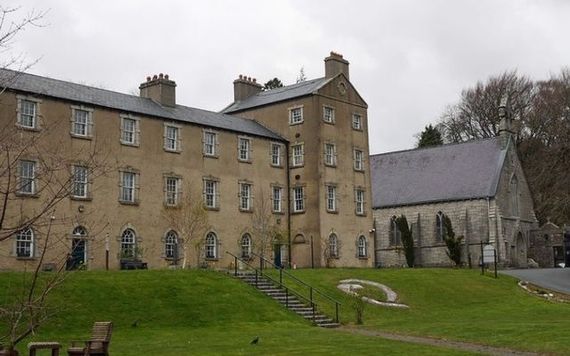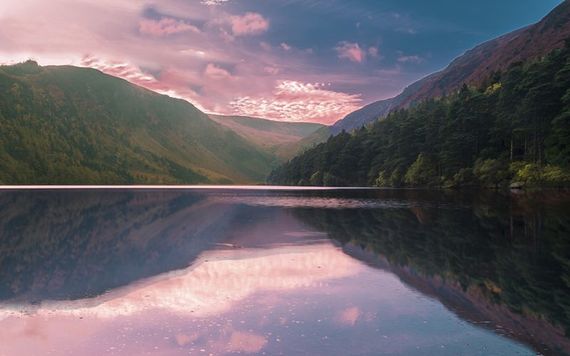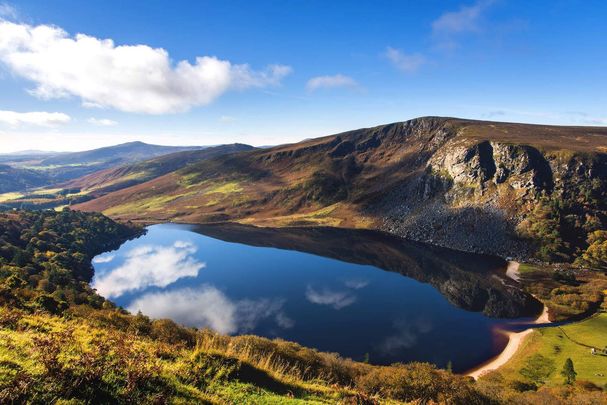Leon O’Cathasaigh cycles through the picturesque hills of Wicklow recalling the history, tales, and legends surrounding Captain Michael Dwyer and his men.
Taken from the July / August 2019 issue of Ireland of the Welcomes magazine. Subscribe to this bi-monthly print magazine here.
Not long ago I spent a wonderful day cycling from Rathfarnham, a suburb of Dublin City, southward into the hills and valleys of County Wicklow. The long road took me from busy streets to ancient forts and quiet valleys. As I traveled I thought about the story of the road, known as the Military Road, and how, through the life of one man, it has come to shape Irish history and contribute to the lore of County Wicklow.
The story begins far away at the other end of the road, in the Glen of Imaal in West Wicklow, and long ago, in the late 1700s when Ireland was in turmoil with the rebellion of the United Irishmen, in Wexford and elsewhere. The rebel Captain Michael Dwyer fought with General Holt at Arklow and Vinegar Hill but they were roundly defeated by the redcoats with many being captured and executed and others rebels fleeing to the hills. With Holt’s blessing, Dwyer decided to return to his homelands in the hills of Wicklow and cause havoc by means of guerrilla warfare.
This article was originally published in Ireland of the Welcomes magazine. Subscribe now!

Looking into the "north prison" of Lug from Camarahill in the Glen of Imaal.
My first climb of the day was the slow drag up through Glencree to the Sally Gap. As the land rises to bleak uplands and wild bog it is easy to appreciate how inaccessible Wicklow would have been over 200 years ago. At the time there was no road going north-south through the county and so Dwyer and his comrades had the run of the land with their local knowledge and ability to attack and disappear into the hills.
Through 1798 and 1801, the British had largely managed to contain the rebellion; holding off the French expeditionary force at Ballinamuck and ruthlessly suppressing the leaders of the United Irishmen.
Wicklow, however, was another matter and Dwyer and his comrades remained at large and continued to harry the local forces and undermine the jurisdiction of the crown.
It was decided that the best way to capture Dwyer was to build a road through the most inaccessible parts of the county and place barracks at strategic points along the route. In that way, the British hoped they could move their forces quickly to deal with any trouble that may arise.
Glencree Barracks is now the site of the modern-day Centre for Peace and Reconciliation but its foundations can be traced back to 1801 when it served as the first outpost along the Military Road.

Glencree Barracks is now the site of the modern-day Centre for Peace and Reconciliation.
Tales remembered
History and folklore often become intertwined and it is difficult to verify all of the stories around the escapades of Michael Dwyer and his remarkable capacity to evade capture. There is one story however, that is well-verified and often retold in poetry and song.
“At length, brave Michael Dwyer, you and your trusty men; Are hunted o’re the mountains and tracked into the glen. Sleep not, but watch and listen; keep ready blade and ball; The soldiers know you’re hiding tonight in the wild Imaal.”
So begins the poem by T.D. Sullivan retelling the events of the night of 16 February 1799, when a band of rebels, including Dwyer, were surrounded by soldiers at Dernamuck, near the Glen of Imaal. The rebels had sought refuge for the night in a farmer’s cottage but their location was betrayed by a local loyal to the crown. The cottage stands to this day and was to be the destination for my cycling excursion through the Wicklow hills.
As my journey continued through Laragh near Glendalough and out to Glenmalure I imagined the plight of Dwyer and the hopelessness of the predicament he found himself in that night.

Glendalough.
Under siege
By all accounts, there were four rebels inside who were completely outnumbered by the troops. Dwyer’s first action was to request safe passage for the family within and it was agreed they would be allowed to leave safely.
When this was completed the rebels were asked repeatedly to surrender but they refused. The British fired into the mud-walled cabin and one of the men named McAllister was badly wounded. They also set fire to the thatched roof of the cottage and the situation for the rebels within was very grave.
McAllister realized he had no hope of surviving and bravely suggested he draw fire upon himself to allow the others to escape. The poem elegantly describes McAllister’s desperate plan.
“Place in my hands a musket, then lie upon the floor: I’ll stand before the soldiers, and open wide the door: They’ll pour into my bosom the fire of their array; Then, whilst their guns are empty, dash through them and away.”
And so it happened. McAllister was killed in a volley of shots and while the soldiers were reloading their rifles the other three rebels made a run for it. Unfortunately, two of the fleeing rebels were killed but remarkably Michael Dwyer escaped into the snowy hills. He had become a legend.
Barracks were built at Laragh and Glenmalure to establish control of the Military Road. However, Dwyer continued to evade capture and continued to embarrass the crown forces. There is little trace of these barracks today but the bustling tourist village of Laragh and access to the monastic settlements of Glendalough were all enabled by the building of the Military Road to capture Michael Dwyer. It is said that Dwyer had a hiding place in Glendalough using St Kevin’s Cave as a refuge and lookout.
As I descended into Aughavannagh, I was mesmerized by the landscape and absorbed by the wonderful and tragic history of the places along the way. The hawthorn were in full bloom and in places wild carpets of bluebells covered the shady ground.
As I approached the Glen of Imaal I followed the signs for the Dwyer McAllister Cottage. I left my bike by the road and walked up past a farmhouse along a stone path. The cottage has been well maintained and is in great condition. I sat by the entrance imagining the firefight and the gallant escape and selfless heroism.

Love Irish history? Share your favorite stories with other history buffs in the IrishCentral History Facebook group.
An epic life
What happened to Michael Dwyer after those events? Well, that’s another story in itself. Dwyer surrendered in 1803 and was promised safe passage to America. He was held in prison until 1805 when at short notice, he was shipped to Sydney Australia not America. His travails did not end there, however. The Governor of New South Wales, William Bligh (of Mutiny on the Bounty fame) did not trust Dwyer and had him tried for sedition. Although found ‘not guilty’ Dwyer still had to serve time in Van Diemen’s Land and other convict depots. When Bligh was eventually removed from office Dwyer was allowed to return to his family, who had traveled with him to Australia, and the plot of land he’d been granted on arrival.

Michael Dwyer (1772–1825) was a Society of the United Irishmen leader in the 1798 rebellion.
Remarkably, he went on to serve as an innkeeper and a police constable eventually becoming Chief of Police at Liverpool. in New South Wales. Dwyer died in Sydney on the 23rd of August, 1825 and was subsequently buried in Waverley Cemetery where the monument over his grave declares him the ‘Wicklow Chieftain’.
The Military Road is a challenging cycle with many steep climbs and dangerous descents. Like the ups and downs of the life of the man who caused it to be built, the road holds a special place in the story of Ireland and in the lore of the wild county of Wicklow.
Taken from the July / August 2019 issue of Ireland of the Welcomes magazine. Subscribe to this bi-monthly print magazine here.
Updated in May 2024.




Comments